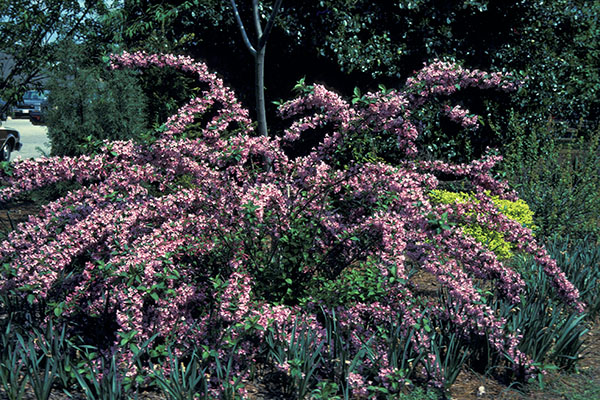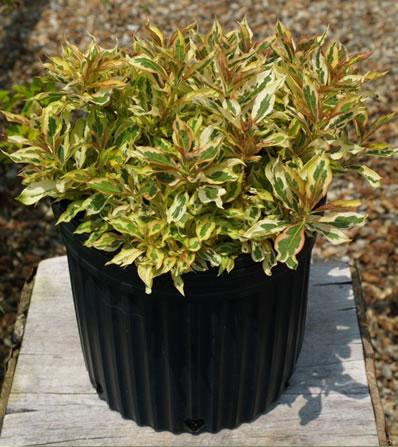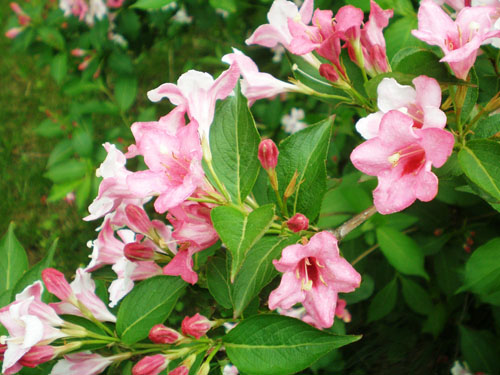The Old-Fashioned Weigela
By Linda Puff, Fairfax Master Gardener

Old fashioned weigela
The Weigela, Weigela florida, known as an old-time landscape favorite and a staple for the shrub border, produces a springtime display of funnel-shaped 1-inch long beautiful flowers.
While growing up, I remember a rather large Weigela planted in the backyard of my family home. In the spring it was filled with lots of pretty pink flowers. When the blooms were finished, my dad trimmed the shrub back some. I remember it was not particularly attractive out of bloom. It just faded into the landscape. A deciduous shrub with no real fall color, it shed its leaves in the fall/winter.
A member of the Caprifoliaceae family, made up of shrubs and vines including the honeysuckle, the Weigela is a native to parts of Asia. It was imported to Europe in the 1800s. The genus name Weigela honors Christian Ehrenfried Weigel (1748-1831), a German professor at the University of Gerfswald.
Over the years, the Weigela has been undergoing a lot of breeding innovation, and the new cultivars have fueled a well-deserved comeback, making them a popular choice in the ornamental landscape. The efforts of plant breeders working overtime with Weigela have yielded versions that unfurl dark green, burgundy or variegated leaves, making them attractive throughout the season, and flowering light pink, red or white blooms from late spring to fall. Some will re-flower throughout the growing season, like ‘Sonic Bloom’. The new Weigela selections come in every size category from one that is perfect for a small yard, planting bed or a pot, to one that can create a hedge, like ‘Fine Wine’ Weigela. A low growing, spreading variety can be a ground cover or hold down a slope. In late fall, the blossoms will make room for some fruits that are dry capsules containing many tiny and winged seeds that are often used as propagation material.
Best planted in early spring or late fall, the Weigela is easy to care for. Many dwarf varieties need almost no maintenance. Simply trim back any dead wood in the spring. Large varieties may need pruning throughout the growing season to maintain shape. The easiest method to trim the old-time Weigela, which can become straggly, unkempt and larger than intended, is to cut back the entire plant about halfway, just after the blooms fade; do this every other year. This should result in dense new growth, providing plenty of flowers the next spring. We always say right plant, right location! It is also important to remember to prune at the right time, after a blooming season. Otherwise, there is a risk of losing next spring’s flowers.

‘My Monet’ Weigela
Weigela shrubs are not too picky in planting locations but prefer full sun for the biggest flower show and deepest foliage color. Exceptions are in the hottest regions of the country where plants prefer light afternoon shade to protect the plant, and varieties with variegated leaves tend to burn if they receive full sun. The ‘My Monet’ Weigela changes color depending on light level, yielding whiter leaves in shade and pinker tones in full sun.
The Weigela is a pretty tough plant. Some say it has a no-fuss personality, is undemanding and carefree in the landscape. This plant is hardy in 4 to 8 USDA zones. A good planting time is during the cooler months of spring or fall, avoiding the extreme summer heat. This shrub needs plenty of room to grow to allow its roots and foliage to develop properly, so don’t overcrowd when planting. Plant in moist, mildly acidic soil that drains well. Add plenty of compost or composted manure to the planting bed to help enrich soil and improve drainage. Newly planted Weigela bushes need consistent watering until established. After that, water is not needed unless we have an unusually dry season. Feed once a year in the spring using an all-purpose fertilizer.

Weigela florida
They can occasionally be targeted by aphids, spider mites, plant bugs or scale insects. Handpick the pests, if possible, or spray with water to remove them. Afterwards, apply a suitable treatment, such as a horticultural oil or natural insecticide. Fungal diseases can include powdery mildew or root rot. Before acting, consult the Virginia Cooperative Extension Pest Management Guide for best practices. The Weigela has coarse textured leaves that deer leave alone, though extreme conditions can result in deer grazing.
Weigelas in the landscape garden design are very attractive to pollinators including bees, hummingbirds and butterflies. The taller variety of shrub is a good nesting site and shelter for some bird species. These shrubs are not harmful to pets or children if touched or ingested.
There may be some individuals who will appreciate that the leaves of some Weigela shrubs are a tasty addition in the preparation of teas, and some consume their young leaves cooked.
No matter where you plant a Weigela, the spring blooms will definitely make a statement. If you have some extra space in your garden, add this shrub to your list for this year.
References
• Old Fashioned Weigela, Alex X. Niemiera, Professor, School of Plant and Environmental Sciences,
Virginia Tech, Virginia Cooperative Extension Publication 2901-1060
• Weigela, The Southern Living Garden Book, page 590
• How to Grow Weigela Bush, David Beaulieu, updated July 2021, The Spruce
• How to Grow and Care for Weigela, Julie Martens Forney, HGTV
• 2022 Virginia Pest Management Guide, Home Grounds and Animals, Control of Ornamental Diseases,
Chapter 4